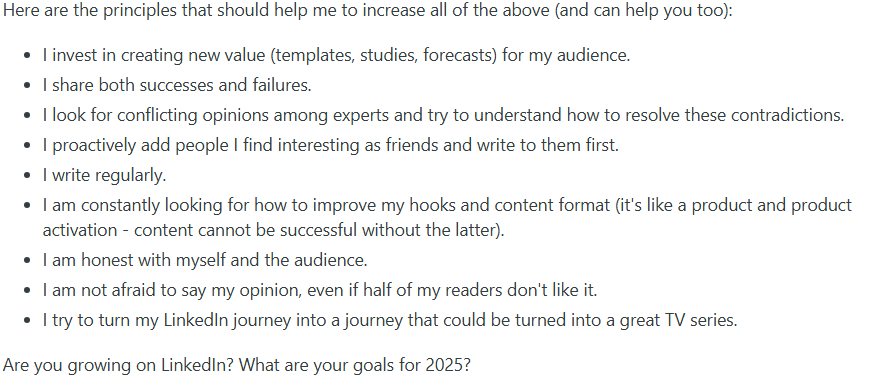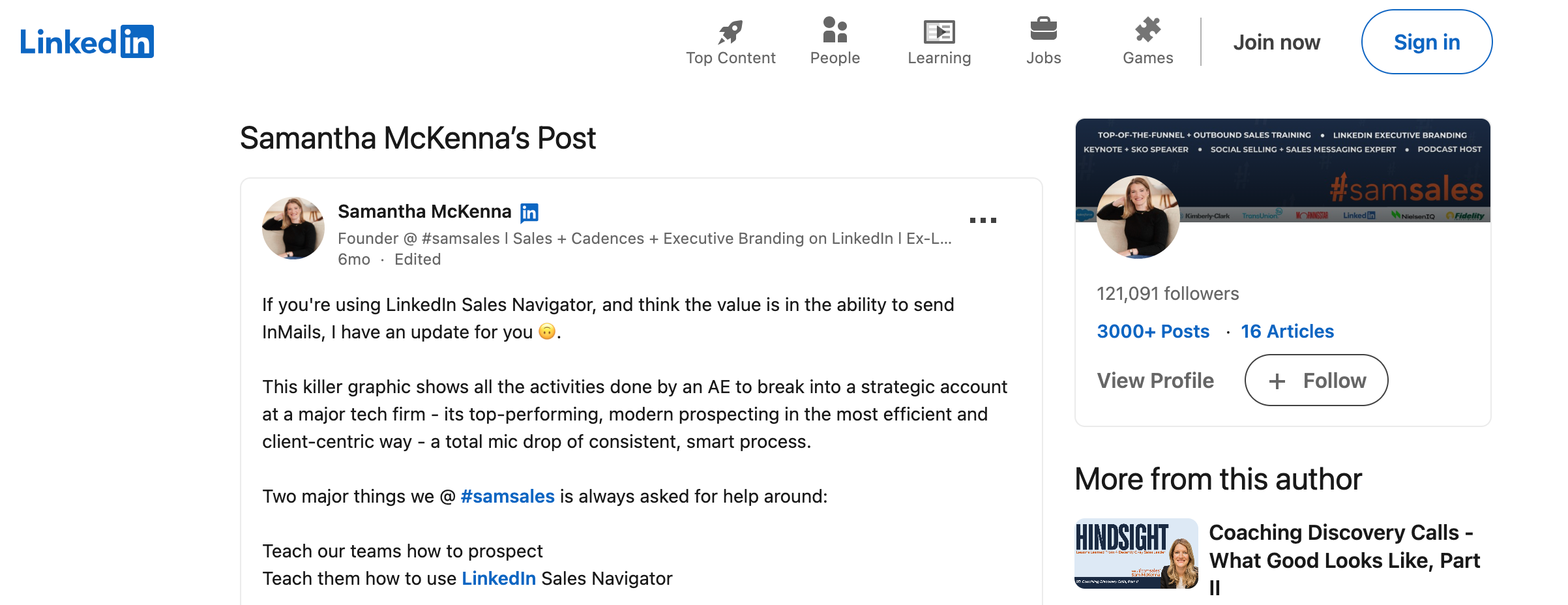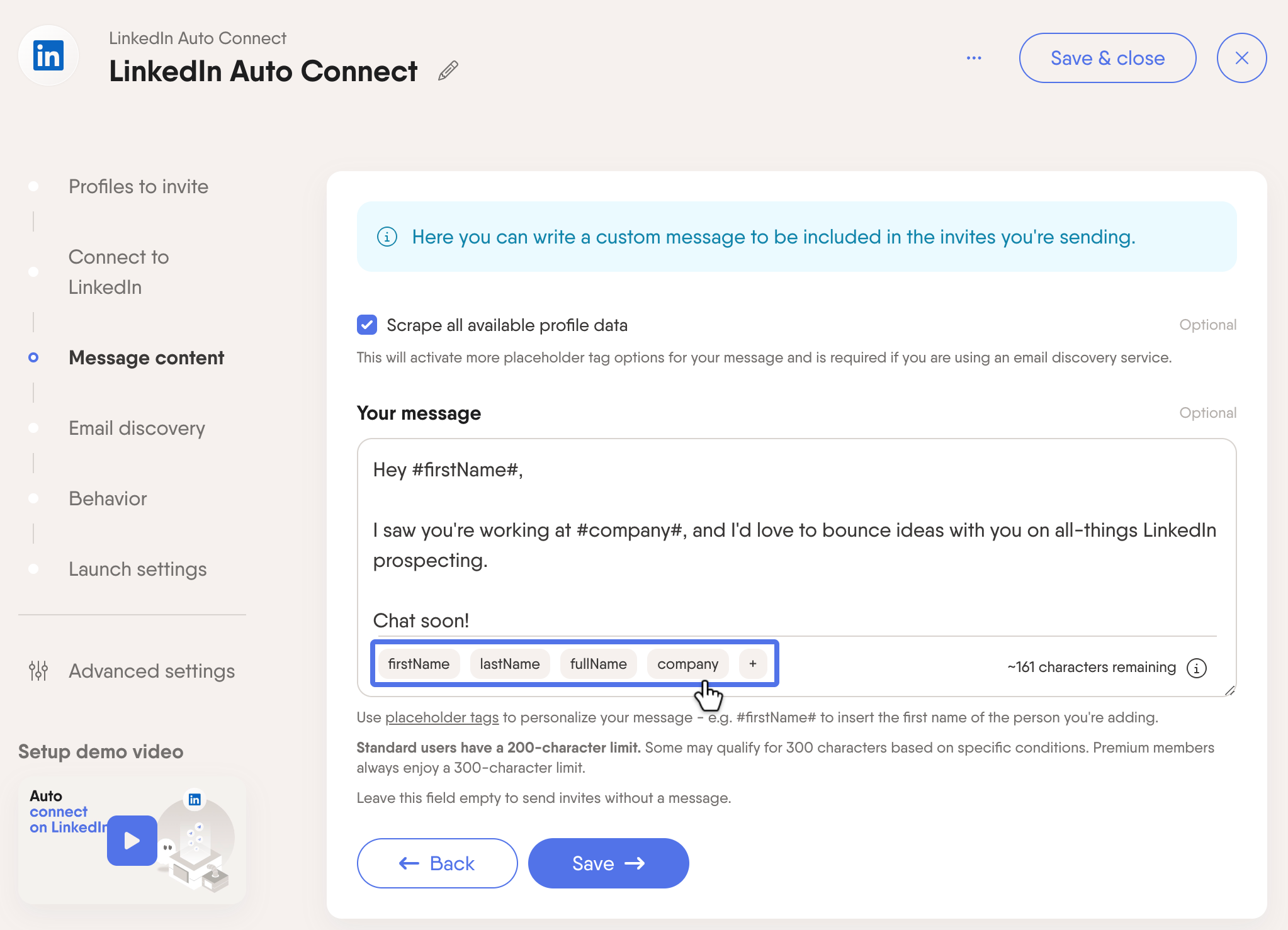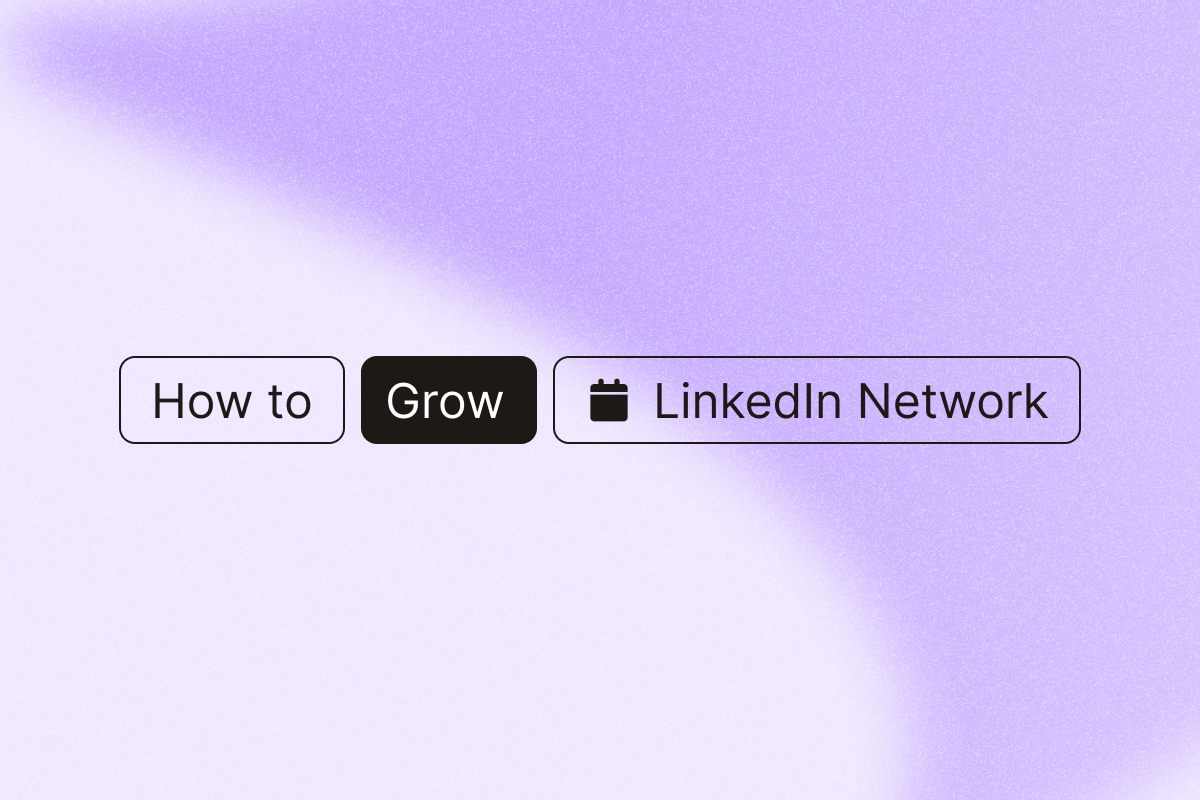Most LinkedIn networking advice treats all professionals the same. But as a sales rep, you’re not building a network to find a new job or get noticed by recruiters. You are building a qualified prospect pipeline that directly impacts your quota.
This is what top-performing sales reps do differently. They use strategic networking to turn LinkedIn connections into warm introductions, referral opportunities, and direct prospects. While average reps send generic messages to anyone with a C-suite title, elite performers build targeted professional networks to generate a consistent pipeline.
Below are seven proven plays with steps and templates you can use today to turn LinkedIn connections into pipeline.
Why sales networking differs from general networking
Sales networking isn’t about collecting connections. It’s about building systematic access to your target accounts.
Your professional network should function as a revenue-generating asset with three core purposes: direct prospect access, warm introduction pathways, and social proof during sales conversations.
Focus on decision-makers and influencers who match your ICP (title, company size, tech stack, region). Make each connection request and comment serve a goal: book a call, get an intro, or qualify interest.
Foundation: Optimize your LinkedIn profile for sales credibility
Your LinkedIn profile serves as digital sales collateral when prospects research you before accepting connection requests. Optimize your profile for buyers, not recruiters, so prospects trust you and book meetings.
- Professional profile picture showing confidence and approachability
- Headline focused on the value you provide to your target audience, not just your job title. Template: “We help [ICP] [solve X] so they can [result].”
- About section structured like sales collateral: problem you solve, unique approach, social proof, clear call-to-action. CTA example: “Open to a 15-minute teardown? Calendar in Contact info.”
- Profile with detailed information and relevant skills to make you more visible to potential connections
Key optimization tactics:
- Include buyer terms your ICP searches: e.g., “pipeline visibility,” “lead routing,” “quote-to-cash”
- Add 1–2 proof points: “Helped Series B SaaS reduce no-shows 32% (Q2 2025)”
- Add your work email and calendar link in Contact info
- Prioritize buyer outcomes over self-promotion
- Create and share content to showcase your expertise and attract organic followers
Automation tip: Use PhantomBuster’s LinkedIn Profile Export automation to collect profile elements from top sellers and spot patterns to mirror (headlines, featured assets, CTAs).
Strategy 1: Reverse-engineer your best customers’ networks
Your happiest customers know other companies facing similar challenges. Skip cold lists. Tap customer contacts for intros to look-alike prospects.
Process:
- Identify customer champions who achieved significant results.
- Export their visible connections and filter by title, company size, and region.
- Request specific introductions that benefit both parties.
- Follow up systematically with easy-to-forward templates.
Example approach: “Sarah, I noticed you’re connected with [Prospect Name] at [Company]. Given the 40% efficiency improvement we achieved, [Prospect] might benefit from learning about our approach. Would you be comfortable making a brief introduction?”
Charlotte Lloyd shared a step-by-step way to connect with top prospects in the same industry without needing a premium subscription on LinkedIn.
Strategy 2: Cross-platform intelligence for personalized outreach
The best LinkedIn outreach uses intel from other platforms where prospects share insights and engage in discussions. This approach provides personalization opportunities that competitors miss.
- Slack community prospecting: Join industry-specific groups where your target audience participates. Monitor discussions to identify prospects facing challenges, then use shared community membership for LinkedIn connection context.
- Message template: “Hi [Name], I enjoyed your insights in the [Community Name] Slack about [specific topic]. Your perspective on [challenge] resonated with similar experiences I’ve seen with other [industry] leaders. Would love to connect here as well.”
- X and forum intelligence: On X, follow the accounts your ICP engages with. Reply with one concrete takeaway you’ll apply, then use shared interests for LinkedIn outreach.
- Virtual events and webinar attendees: Only use publicly available lists and follow event privacy rules. Don’t mass-message. Reference shared attendance for natural conversation starters.
Strategy 3: Use LinkedIn events and networking opportunities
Industry events provide shared experiences that make outreach feel organic. Reference a specific session: “Your comment in ‘Scaling RevOps’ mirrored what our fintech clients face—mind if I share a 2-minute playbook?” Maximize ROI through pre-event research, real-time engagement, and systematic follow-up.
1. Pre-event networking
- Review attendee lists to identify target prospects
- Send connection requests referencing shared attendance
- Suggest brief meetups during the event
2. Real-time engagement
- Monitor event hashtags and LinkedIn posts
- Like and comment on prospects’ event-related content
- Save public attendee links or notes, and reach out 1:1 with context. Avoid bulk list capture
3. Post-event follow-up
Reference specific sessions or insights in personalized messages, even if you didn’t speak directly during networking events.
Strategy 4: Join LinkedIn Groups strategically
LinkedIn Groups offer direct access to industry professionals discussing relevant challenges. Join 2–3 groups where your ICP posts weekly. Track active threads on challenges you solve.
Group selection criteria:
- High engagement from your ICP
- Regular discussions about the challenges you solve
- Active moderation and quality content
- Industry-specific focus aligned with your solution
Engagement strategy:
- Post a teardown: “3 mistakes fintech RevOps teams make with onboarding SLAs (and fixes)”
- Answer questions with genuine interest and expertise
- Connect with active group members using shared group membership as context
- Monitor discussions for prospects mentioning specific challenges
Strategy 5: Content creation for network growth
Publish short posts from recent sales calls (anonymized) to draw in look-alike prospects. Focus on content that demonstrates expertise and creates meaningful connections rather than direct promotion.
Content types that work:
- Industry insights from customer conversations (anonymized)
- Responses to trending topics affecting your target audience
- Questions that start conversations with potential connections
- Success stories showcasing client results (with permission)
Engagement tactics:
- Tag only when you reference their work or quote them, and limit to 1–2 tags
- Create content that encourages meaningful discussions
- Share others’ relevant content with thoughtful commentary
- Use LinkedIn’s search: filter Posts > Past week > your ICP’s hashtags to spot questions to answer
A good example of the power of content is the story of Ivan Palii. He grew his network to 10,000 followers in 10 months. Here’s a sneak peek of his guiding principles for maintaining his LinkedIn network.

We leverage PhantomBuster to strategically build and cultivate relationships with targeted personas for our B2B influencers. The platform enables us to precisely identify prospects by their LinkedIn job titles and roles, and then create personalized connection requests at scale. Our results speak volumes—acceptance rates that are 5-10x higher than other approaches. – Patrick Spencer, VP at Kiteworks“
Strategy 6: Use mutual connections and warm introductions
Mutual connections are often the fastest path to a first meeting. Invest in connectors who can introduce you to 2–3 peers each quarter.
Systematic approach:
- Identify mutual connections between you and target prospects.
- Strengthen relationships with key connectors in your network.
- Request specific introductions with clear value propositions.
- Offer reciprocal introductions when possible.
Introduction request template: “Hi [Connector], I noticed you’re connected with [Prospect] at [Company]. I’ve been working with similar companies on [specific challenge] and think [Prospect] might find our approach valuable. Would you be comfortable making a brief introduction?”
If you’re using Sales Navigator, sales leader Samantha McKenna has some excellent tips and tricks on expanding your LinkedIn network. Her post focuses on how to target the right people in your industry.

Strategy 7: Automate winning tactics while maintaining personalization
Once you identify networking approaches that consistently generate qualified prospects, strategic automation helps scale successful processes without sacrificing quality. You can run these with PhantomBuster’s pre-built automations.
The 3-step workflow:
- Find: Use PhantomBuster’s LinkedIn Search Export automation to pull ICP profiles based on title, company size, and region
- Enrich: Run profiles through the AI Enricher to gather contact details and company insights
- Connect: Deploy Auto Connect and Message Sender automations to send personalized requests and timed follow-ups—within safe daily limits
Maintain human elements:
- Personalized message content based on research
- Responses to prospects showing genuine interest
- Strategic conversation development
- Relationship nurturing beyond the initial connection
PhantomBuster automations for scale: Use LinkedIn Search Export automation to pull ICP profiles, then Auto Connect and Message Sender automations to send personalized requests and timed follow-ups, within safe daily limits.

Follow up with your new LinkedIn connections
Making a connection is just the first step. You need to stay relevant and visible to keep your LinkedIn connections warm and turn them into meetings and opportunities. To do that, you need to go further than just having relevant content on your LinkedIn profile.
Fostering connections is key. Craig Severinsen speaks about the importance of being human in building relationships on LinkedIn. Interacting with people and their posts is how you get recognized and establish yourself as the go-to person for your product or service. You can read his entire blog here.
Let’s take a practical example. Imagine you just connected with a fellow member of a professional group. Here’s how to follow up without being salesy:
- Wait a few days: Let the new connection breathe.
- Reference your shared context: Mention the group you’re both in.
- Lead with value: Mention a relevant pain point discussed in the group and offer a helpful resource or insight, not a pitch.
Consistently helping without asking builds trust and keeps you top of mind.
Daily networking routine that fits your sales schedule
Dedicate 20 minutes daily to high-impact activities that support pipeline goals:
Daily (20 minutes):
- 5 minutes: Review notifications and respond to messages.
- 10 minutes: Schedule 2 meaningful comments on ICP posts (add insight or data, not emojis).
- 5 minutes: Send 5–15 personalized requests (stay within LinkedIn limits and your acceptance-rate goals).
Weekly (1 hour):
- Research new prospects using cross-platform intelligence.
- Create valuable content that attracts your target audience.
- Review metrics and optimize underperforming approaches.
Focus areas: Prioritize quality over quantity. Better to send fewer, personalized connection requests than mass-generic messages that damage your professional reputation.
Read more about how discipline wins time and again in this post by Benjamin Douablin.
Measuring what matters: Sales networking KPIs
Track metrics that correlate with sales performance rather than vanity metrics like total connection count. These benchmarks come from our customer data and should be adjusted by industry and deal size.
| Metric | Target | Why it matters |
|---|---|---|
| Connection acceptance rate | 40–60% | Indicates targeting quality |
| Response rate from new connections | 15–25% | Shows engagement effectiveness; set a baseline by industry and adjust monthly |
| Connection-to-meeting rate | 5–10% | Measures sales conversion; calibrate by persona and deal size |
| Monthly referrals from network | 2–5% | Demonstrates relationship value; measured as % of new meetings sourced by introductions |
This case study by Prathamesh Sakhadeo reports a 300% pipeline increase after a tech startup implemented targeted LinkedIn strategies.

FAQ
How many connection requests should I send daily?
Aim for 5–15 personalized requests, tuned to maintain a 40–60% acceptance rate. Focus on prospects matching your ICP rather than maximizing volume. Higher acceptance rates from targeted outreach generate better results than sending generic messages.
What’s the best approach for connecting with industry professionals?
Research prospects thoroughly and reference specific commonalities in your connection request. Mention shared connections, recent posts they’ve shared, or industry events you both attended. Avoid generic messages. Use LinkedIn filters to find look-alike accounts and reference a recent post or event.
How do I avoid coming across as pushy when networking on LinkedIn?
Focus on building genuine relationships rather than immediate sales outcomes. Engage with prospects’ content before connecting. Share a short insight or resource tied to their role.
Should I connect with prospects if I only have their phone number?
Don’t send a request just because you found their phone number. Only reach out if you have a clear business context or mutual connection.
How can I identify relevant skills and interests for personalization?
Scan Activity for last two posts, Featured for assets, and Skills for tool keywords to reference in your opener. Check their company’s recent news and industry challenges to craft connection requests that demonstrate genuine interest in their work.
What’s the biggest mistake sales reps make when trying to grow their LinkedIn network?
Sending connection requests without personalization and immediately pitching after connections are accepted. This approach creates negative first impressions and wastes networking opportunities. Focus on relationship building first, with sales conversations second. Try: “Saw your post on [topic]. We helped [peer company] with [result]. Open to compare notes?”
How do I maintain relationships with existing connections while growing my network?
Regularly engage with existing connections’ content, share relevant opportunities, and make strategic introductions between contacts when appropriate, especially around events. Share notes from sessions and introduce two contacts who should meet. Use content creation to stay visible to your entire network while adding new professional connections.
